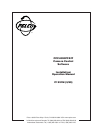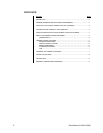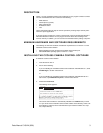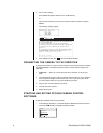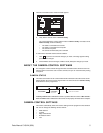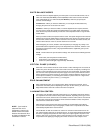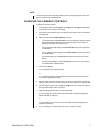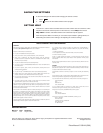
6 Pelco Manual C1931M (5/99)
WHITE BALANCE MODES
When the camera is adjusted properly, the white parts of a scene should be white, not an-
other color. Automatic (Full Auto) and fixed (Fixed) modes set the camera’s white bal-
ance automatically for you, while remote (Full Remote) mode lets you specify the
camera’s control settings.
Full Remote – When you choose Full Remote, you can adjust the white balance by
changing the percent of red or blue in the scene.
Full Auto – When you choose Full Auto, no further adjustments are required; however,
you may want to change the speed of the white balance. In Full Auto mode, the white bal-
ance continuously and automatically corrects the color temperature within a range of 2500
to 6500 Kelvin.
When you select Full Auto, the Speed control is active. The speed changes the time interval
between two successive white balance measurements in the camera. The minimum time in-
terval for PAL cameras is 20 ms, and the maximum is 2.3 seconds. For NTSC cameras, the
minimum time interval is 16.67 ms, and the maximum is 2 seconds.
When the lighting of a scene (related to color temperature) is changing very slowly, a low
speed white balance adjustment gives you the best performance. However, when the color
temperature changes fast or often, a high speed white balance adjustment gives you the
best performance.
Fixed – Fixed modes have pre-set balance settings. The camera has the following balance
settings:
• fixed indoor (color temperature of 3200 Kelvin)
• fixed outdoor (color temperature of 5600 Kelvin)
• fixed FL/TL (fluorescent light of approximately 4500 Kelvin)
VERTICAL PHASE (V-PHASE)
When two or more cameras share the same monitor or VCR, switching from one camera to
another may cause the picture to roll on the monitor and cause a temporary recording mal-
function on the VCR. Rolling occurs when cameras are not synchronized. To prevent rolling,
the Line-Lock control synchronizes the power supply so that it is in phase with the camera.
Phase variations in the power supply can cause phase variations between cameras. To cor-
rect the phase variations, you can change the camera’s V-phase control in 1-degree incre-
ments to a maximum of plus or minus (+/-) 313 degrees.
EDGE ENHANCEMENT
Edge enhancement gives you a sharper picture. Edge enhancement, however, also in-
creases the noise in the picture. Depending on how you use the camera, you can turn the
Edge Enhancement control off to reduce the noise in the picture.
ILLUMINATION CONTROL
The camera uses the AGC (Automatic Gain Control), Iris, and Shutter controls for illumina-
tion adjustment. The AGC control is always active. However, depending on the type of lens
mounted on the camera, either the Iris or the Shutter control is active; both are not active at
the same time. Fixed-iris and manual-iris lenses activate the Shutter control, and passive
auto-iris lenses activate the Iris control.
AGC keeps the output signal of the camera constant for an illumination range. When a
scene is dark and contains only a few highlights, realistic color is reproduced as the AGC
automatically amplifies to the maximum level.
Iris and Shutter are both Iris controls. You use the Iris control for mechanical-lens iris con-
trol, and the Shutter control for an electronic-lens iris. In scenes where background illumina-
tion forms a highlight compared to the main subject, the subject appears very dark on the
monitor. (This occurs, for example, when a person stands in front of a window.) You must
compensate for the lighting by realigning the controls so that the main subject is clear.
NOTE:
If you install an
electronic lens on the
CCC40001-2 camera, the
Shutter control is not valid
because the electronic shut-
ter feature is disabled on the
CCC40001-2 camera.



